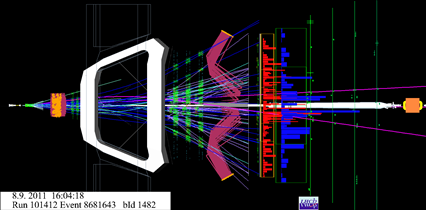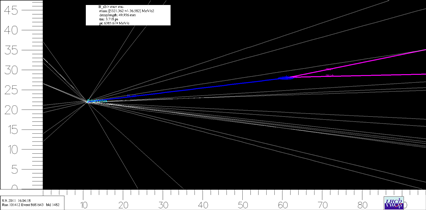The LHCb Collaboration has just presented at the 2013 European Physical Society Conference on High Energy Physics, EPSHEP, Stockholm, Sweden, improved measurements for the rare decays B0s→μμ and B0→μμ. Last year at the Hadron Collider Particle Symposium in Kyoto, the Collaboration presented the first evidence, with 3.5σ significance, for the B0s→μμ decay using the total 1.0 fb-1 of data taken in 2011 and 1.1 fb-1 of the data accumulated in 2012, see 12 November 2012 news. The full LHCb data sample of 3.0 fb-1 was used to obtain today’s result. The analysis strategy is very similar to that reported in November 2012 with an improved event selection algorithm (BDT). The significance of the result has been improved to 4.0σ making the evidence even stronger. A branching fraction of (2.9+1.1-1.0)x10-9 is obtained. The result is in agreement with the Standard Model prediction of (3.56±0.29)x10-9. It puts very strong constraints on the parameters of different models of new physics and squeezes even more than previous results the parameters of supersymmetric extensions of the Standard Model (SUSY) – see 30 March 2012 news for introduction.
The μ+μ– invariant mass spectrum for the BDT selection algorithm bins with the smallest background contribution is shown in the left image. The solid blue line shows that the data distribution presented as black dots is well understood and can be separated into different components presented with the help of different colour lines. The dashed red narrow distribution shows the B0s →μμ contribution around the B0s mass of 5372 MeV/c2. The green dashed line shows a possible B0 contribution. The B0 decay yield is not significant yet and an improved limit on the B0→μμ branching fraction of 7.4×10-10 at 95% CL is obtained.
.
click the images for higher resolution
A typical B0s →μμ decay candidate event is shown below. The two muon tracks from B0s decay are seen as a pair of purple tracks traversing the whole detector in the left image below. The right image shows the zoom around the proton-proton collision point, origin of many particle tracks. The two muon purple tracks originate from the B0s decay point located 50 mm from the proton-proton collision.
Read more in the LHCb presentation in Stockholm and in the LHCb paper and in the CERN Press Release.



